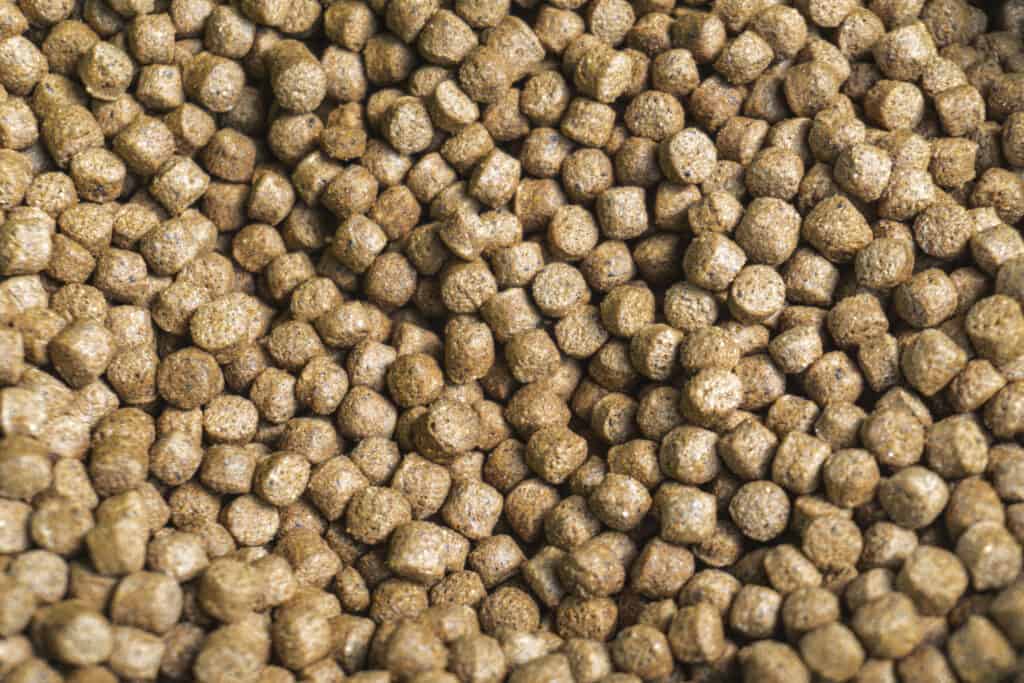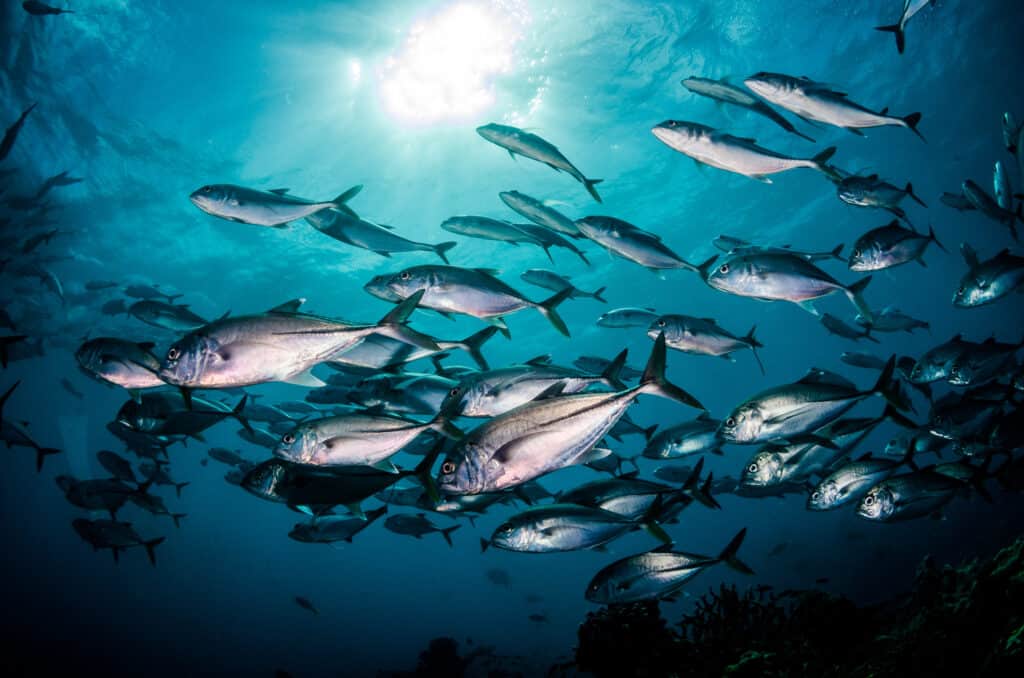“Order 75!”
You look down at your crumpled receipt – your burger is ready. You walk up to the counter and reach for your lunch. Before you can grab it, the server snatches it out of reach.
“Wait!” he exclaims, “There’s something you should know: this beef came from farm raised cows.”
Obviously.
We’ve come to accept that our beef – along with our lamb, chicken, and pork – comes from a farm. But what about our seafood? If order 75 was a salmon fillet, would it be as obvious? 75 happens to be the percentage of total salmon consumed world wide that is farm raised.
So maybe the fact that your fillet did come from a farm, or aquaculture, should be obvious.
What is aquaculture?
Simply put, aquaculture is growing stuff in water. That “stuff” can be salmon, seaweed, oysters, and more. Aquaculture can be done in the ocean (offshore/marine aquaculture) or on land (onshore aquaculture). Onshore farms can be in ponds, rivers, or tanks, and tank farms can raise freshwater species or saltwater species.
Here are a couple of examples of aquaculture in each category:

Offshore
Onshore – Freshwater
Onshore – Saltwater
Today, aquaculture is the fastest growing food production sector in the world, and it produces over half of the world’s seafood (FAO).
Why is the aquaculture sector growing so quickly?
A big reason: we need more sustainable food.
The demand for protein is increasing at a faster rate than the growing population, and it’s not slowing down. The United Nations projects the population to be at 10 billion by 2050 – a 29% increase from today. By then, the demand for protein is expected to have increased 52% (Global Seafood).
And increased production of traditional proteins is not an option.
Low feed efficiency and greenhouse gas emissions of traditional protein production along declining worldwide fish make aquaculture an important player in future food security.
Feed Efficiency

Feed for animal agriculture is inefficient at best: it takes 2 pounds of feed to produce 1 pound of chicken. This feed conversion ratio is even higher in pork and beef – 3:1 and 7:1 respectively (tabledebates.org). The feed conversion ratio of farmed fish comes out to an average of 1:1. In regard to the efficiency of protein specifically, NOAA Fisheries gives the following statement:
“Globally, aquaculture uses about .5 metric tons of wild whole fish to produce one metric ton of farmed seafood, meaning that aquaculture is a net producer of protein.”
Greenhouse Gases

Animal agriculture accounts for 14.5% of greenhouse gas emissions every year (FAO). Scaling up this kind of production wouldn’t just mean more methane from cows. It would also mean more land for grazing and growing feed, which equates to fewer forests and even more greenhouse gases.
Aquaculture is much lighter on the planet. In a 2020 scientific report by Nature, researchers estimated that in 2017, aquaculture production contributed to only .049% of greenhouse gas emissions. In fact, some forms of aquaculture have the potential to remove carbon from the atmosphere–this is one of the main goals of seaweed farming.
Fish Stocks

The capture seafood industry also contributes minorly to greenhouse gas emissions, but ocean stocks are a limited resource. Much is being done to ensure that we fish in a way that allows ocean populations to maintain their numbers. In the U.S., NOAA Fisheries and regional fishery management councils establish regulations to prevent overfishing, decrease bycatch, and stop illegal fishing. They also implement programs to rebuild overfished stocks.
American seafood wholesalers like Safe Coast Seafoods aim to preserve ocean stocks by focusing on U.S. caught fish species, like groundfish, that are managed by these governing bodies. Unfortunately, other countries have yet to adopt as high of seafood sustainability standards, evidenced in an increasing number of overfished stocks worldwide (Our World in Data).
Aquaculture does not take from the ocean stock, and, in some cases, replenishes it. As the seafood demand continues to rise, sustainable fisheries and aquaculture will continue to meet that demand together.
While aquaculture is efficient, carbon light, and productive, it’s still far from perfect. Below we discuss challenges keeping aquaculture from being at its very best.
Challenges of Aquaculture
Escape of farmed species into the wild, disease and parasites, and pollution are some of the aquaculture challenges being tackled by private and public partnerships worldwide.
Escape
While stock replenishment aquaculture intentionally releases farmed species into the wild, there are unintended escapes from food fish farms. Atlantic salmon is the most pronounced example of this. In some areas, farmed salmon that escape into the wild compete with members of the native population for resources. Interbreeding between farmed and native species produce offspring that has a low survival rate, putting the native population at risk.
Solutions being worked on:
- Determining and improving management practices around stages of rearing that present the highest risk of escape
- Innovations in net pens to prevent escape
- Sterilizing farmed salmon to eliminate the possibility of interbreeding
Disease and Parasites
Any organism, be it cows, humans, or salmon, are more prone to disease in a densely populated area. Offshore salmon farms suffer loss from diseases and parasites because the fish are densely packed. While only healthy farmed salmon is harvested for consumption, economic losses from disease stunt industry progress, and negative environmental impacts of disease are widespread. For example, diseases in a salmon farm may spread to wild species through escape or if the farm is in an area highly trafficked by native species.
Solutions being worked on:
- Antibiotics and vaccines are created and administered under strict regulation. Residual amounts at harvest are far below safe human consumption standards.
- Fallowing periods: allowing recently farmed areas to rest before the next cohort is farmed there
- Rotation of farming locations
- Encouragement of deep ocean farming (away from shore), which dilutes the effects of disease on the surrounding environment
- Improved practices around disinfection and transportation
- Management practices limiting human contact with fish
- Functional feeds: implementing probiotics and other immune-supporting nutrients in fish feeds
- Parasite removal: allowing lump fish into farms to eat sea lice, washing off lice with high pressure water, and using warm water to release lice from salmon skin
Pollution
Uneaten feed and fecal matter accumulate below farms, causing a buildup of nitrogen and phosphorous. These compounds cause abrupt algal blooms that lower water quality, deoxygenate the ocean, and damage natural ocean habitats (EPA).
Solutions being worked on:
- Modeling effects of farms on a given area before issuing licenses to farm in that area
- Underwater monitoring to optimize feed quantities
- Engineering feed to be more absorbent
- Rotating farm spaces
RAS: The Blue Bullet of Sustainable Aquaculture
Recirculating aquaculture systems (RAS) are a solution that addresses all three of the challenges mentioned above. RAS recirculates the same water in a closed system, leaving natural marine environments untouched. They usually take the form of land-based tanks that use advanced filtration, oxygenation, and nutrient distribution to maintain a rich, healthy environment for the farmed species. With RAS, disease and waste can be controlled, and risk of escape is eliminated.
While costly and resource-heavy, RAS will continue to be a major player in the aquaculture industry as it becomes more accessible.
Is eating farmed seafood safe?

A good place to start is asking where your farmed seafood came from.
From there, you can learn about the farm’s certifications, study their farming practices, and learn how they address the challenges listed above.
Eating farmed seafood from the U.S. is a safe choice. The FDA and USDA regulate aquaculture as strictly as they do any other food production process. This includes approving feed, monitoring fish health, and requiring high cleanliness standards.
Supporting American seafood farms has economic benefits as well.
The U.S. imports over 90% of its seafood, and over half of it is farmed. This has contributed to a $16.9 billion dollar seafood deficit (NOAA Fisheries). Supporting American fish farms will not only decrease this deficit, but also create American jobs.
FAQs
NOAA Fisheries does an excellent job at addressing frequently asked questions people have towards aquaculture. Here are some FAQ’s they address:
- Do fish farms use antibiotics? Rarely. Because of better husbandry and vaccine development, antibiotic use in farmed fish has almost disappeared. In the rare case that they are used, their FDA approved and administered by a veterinarian.
- What about diseases? Many farmed fish are vaccinated against diseases, and modern practices prevent the introduction of new diseases in the farming process. At the end of the day, only healthy salmon are harvested for consumption.
- Are farmed salmon injected with dyes? No. Just like wild salmon, farmed salmon get carotenoids–the antioxidant that gives them their distinct color–through their diet.
Summary

- Aquaculture is the practice of growing aquatic animals or plants in water
- Most of the seafood consumed worldwide comes from aquaculture
- Aquaculture has its pros and cons, but the cons are being addressed
- Aquaculture is a sustainable way to meet the rising protein demand
- Choosing U.S. fish farms are an excellent choice for health and economic growth
How does aquaculture work?
Farming aquatic organisms follows 3 general steps:
- Seed – It all begins in a controlled environment. In the case of sugar kelp (an algaculture species), this involves releasing spores from adult plants onto a piece twine submerged in a tank of water. In salmon farming, salmon eggs are hatched in a freshwater tank.
- Growth – The organism is then transferred to the farm where they are nourished* until they reach adulthood. For sugar kelp, it means wrapping the twine around a PVC pipe and submerging it 8 feet into the ocean. In the case of an offshore salmon farm, juvenile fish are transferred to an ocean pen.
- Harvest – When the organisms reach a certain size, they’re harvested and processed. Sugar kelp lines are pulled onto a boat and the crop is cut near the base. Atlantic salmon is transferred via boat to a processing facility.
*The offshore farming of seaweed and bivalves do not require feed as the surrounding waters contain sufficient nutrients for growth.
What else besides food?
Aquaculture is not just a great food system, it has other uses as well. Other uses for aquaculture include:
- Non-food commercial products: Seaweed is used to make bioplastics, biofuel, and natural skin care products (Seaweed Bioplastic Scientific Review)
- Habitat restoration: Coral is grown in a controlled environment and reintroduced to struggling reefs (NOAA Coral Reef Restoration Projects)
- Stock replenishment: Trout hatcheries replenish rivers all over California (California Department of Fish & Wildlife).
Safe Coast Seafoods is one of the largest shellfish and locally caught ground fish suppliers on the west coast. Located in San Francisco, Ca; Crescent City, CA; and Ilwaco WA, we receive the ocean’s finest when it’s freshest, and distribute to local and global customers.
